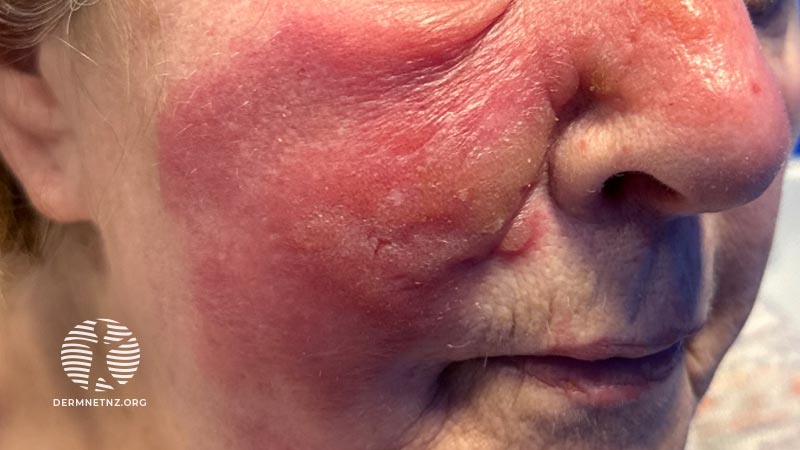Main menu
Common skin conditions

NEWS
Join DermNet PRO
Read more
Quick links
Overnight onset of facial rash
Last reviewed: September 2023
Author: Dr Vidette Wong, Specialty Doctor in Dermatology, Northern Ireland (2023). Reviewing dermatologist: Dr Ian Coulson
Edited by the DermNet content department

Background
This 78-year-old lady presented with a new reddish-orange spreading rash on the right side of her face overnight. The affected skin was raised with a demarcated border and areas of blistering. Her white cell count and C-reactive protein were very raised and she described an episode of fever and rigors.
What is the diagnosis?
This rash and history is classical for erysipelas.
Erysipelas is a superficial form of cellulitis, a potentially serious bacterial infection affecting the skin. Erysipelas affects the upper dermis and extends into the superficial cutaneous lymphatics.
What is the most common causative organism for this condition?
Almost all erysipelas are caused by Group A beta-haemolytic streptococci (Streptococcus pyogenes).
Staphylococcus aureus, including methicillin-resistant strains (MRSA), Streptococcus pneumoniae, Klebsiella pneumoniae, Yersinia enterocolitica, and Haemophilus influenzae have also been found rarely to cause erysipelas.
How do you treat this?
Oral or intravenous penicillin is the antibiotic of first choice. Erythromycin, roxithromycin, or pristinamycin may be used in patients with penicillin allergy. Vancomycin may be used for facial erysipelas caused by MRSA and treatment duration is usually for 10 to 14 days.
Erysipelas tend to recur in up to one-third of patients due to existing lymphoedema or poor lymphatic drainage as a complication of the condition.
